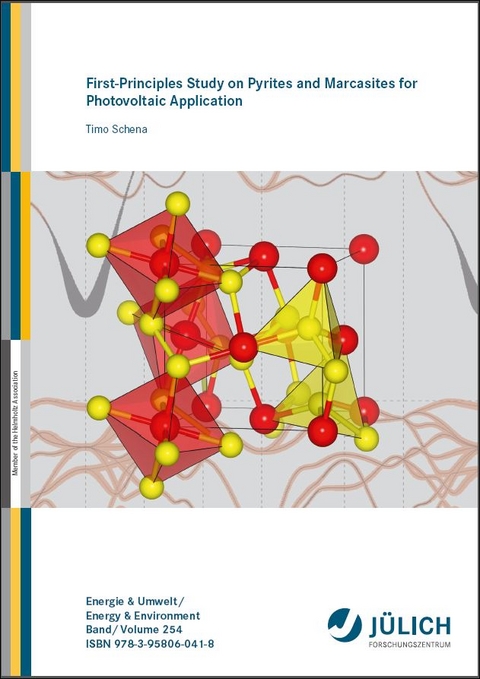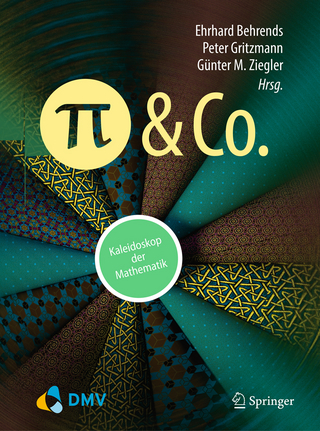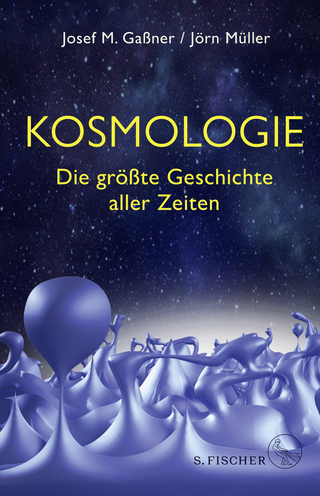
First-Principles Study on Pyrites and Marcasites for Photovoltaic Application
Seiten
2015
Forschungszentrum Jülich (Verlag)
978-3-95806-041-8 (ISBN)
Forschungszentrum Jülich (Verlag)
978-3-95806-041-8 (ISBN)
- Keine Verlagsinformationen verfügbar
- Artikel merken
This thesis deals with first-principles calculations for pyrite and marcasite compounds,
with a particular focus on their suitability for photovoltaic applications. Their electronic
structure and their optical properties are thoroughly investigated within density-functional
theory (DFT) using various exchange-correlation functionals, among them sophisticated
hybrid functionals. To account for electronic excitations the many-body perturbation
theory in the GW approximation has also been exploited.
The investigation of the electronic and optical properties of iron pyrite (FeS2) covers
an essential part of this thesis, since iron pyrite is reported to be a promising material for
photovoltaic applications due to its large optical absorption, a suitable band gap and large
photocurrents. Furthermore, iron pyrite consists of abundant elements, and thus would
allow for a large-scale and long-term utilization. However, iron pyrite solar cells exhibit
only an open-circuit voltage of merely 200 mV, leading to a small conversion efficiency of
3%, which disqualifies iron pyrite for photovoltaic applications at present.
This thesis exposes that the question about the size of the fundamental and optical
band gap of iron pyrite, both, theoretically and experimentally, might not be settled yet.
Low-intensity contributions in the optical absorption might complicate the determination
of the optical band gap, and the GW results show that the fundamental band gap might
be much smaller than expected. Therefore, the small fundamental band gap of pristine
iron pyrite in the bulk phase might be already responsible for the low open-circuit voltage.
Since interfaces and surfaces play an important role for the photovoltaic performance,
the electronic structure of the most stable iron pyrite surfaces is also discussed, revealing
that surface states of Fe 3d character might act as charge recombination centers. First
attempts to passivate these surface states indicate that heavier adatoms are more suitable
than light adatoms.
The application of the GW approximation on iron pyrite yields an unconventional reduction
of the band gap compared to the “plain” DFT results, whereas largely overestimated
band gaps are obtained using hybrid functionals. By extending the calculations to other
pyrite compounds (RuS2, OsS2, NiP2 and ZnS2) and to the structurally closely related
marcasite compounds (FeS2, FeSe2 and FeTe2), it is shown that the interplay of transitions
between p and d states and the screening caused by the d states is responsible for this
peculiar behavior.
Finally, a particular focus is set on FeS2 marcasite, which is reported to coexist with
the pyrite phase, but is presumed to degrade the photovoltaic performance. However, the
results in this thesis indicate that iron marcasite might be better suited for photovoltaic
applications than iron pyrite. This thesis deals with first-principles calculations for pyrite and marcasite compounds,
with a particular focus on their suitability for photovoltaic applications. Their electronic
structure and their optical properties are thoroughly investigated within density-functional
theory (DFT) using various exchange-correlation functionals, among them sophisticated
hybrid functionals. To account for electronic excitations the many-body perturbation
theory in the GW approximation has also been exploited.
The investigation of the electronic and optical properties of iron pyrite (FeS2) covers
an essential part of this thesis, since iron pyrite is reported to be a promising material for
photovoltaic applications due to its large optical absorption, a suitable band gap and large
photocurrents. Furthermore, iron pyrite consists of abundant elements, and thus would
allow for a large-scale and long-term utilization. However, iron pyrite solar cells exhibit
only an open-circuit voltage of merely 200 mV, leading to a small conversion efficiency of
3%, which disqualifies iron pyrite for photovoltaic applications at present.
This thesis exposes that the question about the size of the fundamental and optical
band gap of iron pyrite, both, theoretically and experimentally, might not be settled yet.
Low-intensity contributions in the optical absorption might complicate the determination
of the optical band gap, and the GW results show that the fundamental band gap might
be much smaller than expected. Therefore, the small fundamental band gap of pristine
iron pyrite in the bulk phase might be already responsible for the low open-circuit voltage.
Since interfaces and surfaces play an important role for the photovoltaic performance,
the electronic structure of the most stable iron pyrite surfaces is also discussed, revealing
that surface states of Fe 3d character might act as charge recombination centers. First
attempts to passivate these surface states indicate that heavier adatoms are more suitable
than light adatoms.
The application of the GW approximation on iron pyrite yields an unconventional reduction
of the band gap compared to the “plain” DFT results, whereas largely overestimated
band gaps are obtained using hybrid functionals. By extending the calculations to other
pyrite compounds (RuS2, OsS2, NiP2 and ZnS2) and to the structurally closely related
marcasite compounds (FeS2, FeSe2 and FeTe2), it is shown that the interplay of transitions
between p and d states and the screening caused by the d states is responsible for this
peculiar behavior.
Finally, a particular focus is set on FeS2 marcasite, which is reported to coexist with
the pyrite phase, but is presumed to degrade the photovoltaic performance. However, the
results in this thesis indicate that iron marcasite might be better suited for photovoltaic
applications than iron pyrite.
with a particular focus on their suitability for photovoltaic applications. Their electronic
structure and their optical properties are thoroughly investigated within density-functional
theory (DFT) using various exchange-correlation functionals, among them sophisticated
hybrid functionals. To account for electronic excitations the many-body perturbation
theory in the GW approximation has also been exploited.
The investigation of the electronic and optical properties of iron pyrite (FeS2) covers
an essential part of this thesis, since iron pyrite is reported to be a promising material for
photovoltaic applications due to its large optical absorption, a suitable band gap and large
photocurrents. Furthermore, iron pyrite consists of abundant elements, and thus would
allow for a large-scale and long-term utilization. However, iron pyrite solar cells exhibit
only an open-circuit voltage of merely 200 mV, leading to a small conversion efficiency of
3%, which disqualifies iron pyrite for photovoltaic applications at present.
This thesis exposes that the question about the size of the fundamental and optical
band gap of iron pyrite, both, theoretically and experimentally, might not be settled yet.
Low-intensity contributions in the optical absorption might complicate the determination
of the optical band gap, and the GW results show that the fundamental band gap might
be much smaller than expected. Therefore, the small fundamental band gap of pristine
iron pyrite in the bulk phase might be already responsible for the low open-circuit voltage.
Since interfaces and surfaces play an important role for the photovoltaic performance,
the electronic structure of the most stable iron pyrite surfaces is also discussed, revealing
that surface states of Fe 3d character might act as charge recombination centers. First
attempts to passivate these surface states indicate that heavier adatoms are more suitable
than light adatoms.
The application of the GW approximation on iron pyrite yields an unconventional reduction
of the band gap compared to the “plain” DFT results, whereas largely overestimated
band gaps are obtained using hybrid functionals. By extending the calculations to other
pyrite compounds (RuS2, OsS2, NiP2 and ZnS2) and to the structurally closely related
marcasite compounds (FeS2, FeSe2 and FeTe2), it is shown that the interplay of transitions
between p and d states and the screening caused by the d states is responsible for this
peculiar behavior.
Finally, a particular focus is set on FeS2 marcasite, which is reported to coexist with
the pyrite phase, but is presumed to degrade the photovoltaic performance. However, the
results in this thesis indicate that iron marcasite might be better suited for photovoltaic
applications than iron pyrite. This thesis deals with first-principles calculations for pyrite and marcasite compounds,
with a particular focus on their suitability for photovoltaic applications. Their electronic
structure and their optical properties are thoroughly investigated within density-functional
theory (DFT) using various exchange-correlation functionals, among them sophisticated
hybrid functionals. To account for electronic excitations the many-body perturbation
theory in the GW approximation has also been exploited.
The investigation of the electronic and optical properties of iron pyrite (FeS2) covers
an essential part of this thesis, since iron pyrite is reported to be a promising material for
photovoltaic applications due to its large optical absorption, a suitable band gap and large
photocurrents. Furthermore, iron pyrite consists of abundant elements, and thus would
allow for a large-scale and long-term utilization. However, iron pyrite solar cells exhibit
only an open-circuit voltage of merely 200 mV, leading to a small conversion efficiency of
3%, which disqualifies iron pyrite for photovoltaic applications at present.
This thesis exposes that the question about the size of the fundamental and optical
band gap of iron pyrite, both, theoretically and experimentally, might not be settled yet.
Low-intensity contributions in the optical absorption might complicate the determination
of the optical band gap, and the GW results show that the fundamental band gap might
be much smaller than expected. Therefore, the small fundamental band gap of pristine
iron pyrite in the bulk phase might be already responsible for the low open-circuit voltage.
Since interfaces and surfaces play an important role for the photovoltaic performance,
the electronic structure of the most stable iron pyrite surfaces is also discussed, revealing
that surface states of Fe 3d character might act as charge recombination centers. First
attempts to passivate these surface states indicate that heavier adatoms are more suitable
than light adatoms.
The application of the GW approximation on iron pyrite yields an unconventional reduction
of the band gap compared to the “plain” DFT results, whereas largely overestimated
band gaps are obtained using hybrid functionals. By extending the calculations to other
pyrite compounds (RuS2, OsS2, NiP2 and ZnS2) and to the structurally closely related
marcasite compounds (FeS2, FeSe2 and FeTe2), it is shown that the interplay of transitions
between p and d states and the screening caused by the d states is responsible for this
peculiar behavior.
Finally, a particular focus is set on FeS2 marcasite, which is reported to coexist with
the pyrite phase, but is presumed to degrade the photovoltaic performance. However, the
results in this thesis indicate that iron marcasite might be better suited for photovoltaic
applications than iron pyrite.
| Sprache | englisch |
|---|---|
| Maße | 170 x 240 mm |
| Einbandart | Paperback |
| Themenwelt | Sachbuch/Ratgeber ► Natur / Technik ► Naturwissenschaft |
| Schlagworte | Marcasites • Photovoltaic Application • Pyrites |
| ISBN-10 | 3-95806-041-2 / 3958060412 |
| ISBN-13 | 978-3-95806-041-8 / 9783958060418 |
| Zustand | Neuware |
| Haben Sie eine Frage zum Produkt? |
Mehr entdecken
aus dem Bereich
aus dem Bereich
wie sie denkt, fühlt und Probleme löst
Buch | Hardcover (2024)
Folio (Verlag)
26,00 €


